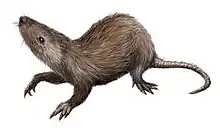Sunnyodon
Sunnyodon is a genus of tiny, extinct mammal, probably of the Lower Cretaceous. Found in what is now southern England and Denmark, it was a relatively early member of the extinct order of Multituberculata. It is part of the suborder Plagiaulacida and family Paulchoffatiidae.
| Sunnyodon Temporal range: Early Cretaceous | |
|---|---|
 | |
| Restoration | |
| Scientific classification | |
| Kingdom: | Animalia |
| Phylum: | Chordata |
| Class: | Mammalia |
| Order: | †Multituberculata |
| Family: | †Paulchoffatiidae |
| Subfamily: | †Paulchoffatiinae |
| Genus: | †Sunnyodon |
| Species: | †S. notleyi |
| Binomial name | |
| †Sunnyodon notleyi Kielan-Jaworowska & Ensom, 1992 | |
The genus Sunnyodon (meaning "Sunny tooth", after Sunnydown Farm) was named by Zofia Kielan-Jaworowska and Ensom P.C. in 1992 based on a single specimen.
Fossil remains of the species Sunnyodon notleyi Lower Cretaceous-age strata of the Lulworth Formation in Durlston Bay, Dorset, England and the Rabekke Formation in Denmark. This is a tooth-based species.
A tooth from the Danish island of Bornholm was assigned to Sunnyodon in 2004. It is the first fossil of a Mesozoic mammal found in Scandinavia.[1]
References
- Lindgren, J.; Rees, J.; Siverson, M.; Cuny, G. (2004). "The first Mesozoic mammal from Scandinavia". GFF. 126 (4): 325. doi:10.1080/11035890401264325.
Sources
- Kielan-Jaworowska & Ensom (1992), "Multituberculate Mammals from the Upper Jurassic Purbeck Limestone Formation of southern England", Paleontology, 35, p. 95-126.
- Kielan-Jaworowska, Z. & Hurum, J.H. (2001), "Phylogeny and Systematics of multituberculate mammals", Paleontology 44, p. 389-429.
